|
| |
Family Eurybrachyidae, Order
Hemiptera
- This page contains pictures and information about Board-frons Planthoppers
Biology general information.
-
 - Female preparing eggs laying site on tree trunk.
-
- The Australian Eurybrachyidae are quite
distinctive from the world fauna. All Australian species belong to the
subfamily Platybrachyinae.
-
- Members in this group are small to medium in size with broad body. They have mottled
forewings and coloured abdomen, usually brown, red, yellow or orange in colour.
All of them have broad frons (front part of head).
-
- Like other members in the Hemiptera order,
Planthoppers have their sucking mouth-parts to feed on host plants by sucking
up the sap.
-
- They can be found resting on the main tree trunk or stems of their host plants, usually Eucalyptus or
Acacia. They are not easily noticed because of their camouflaged
colours. When come closer to them, they will walk to other spots, either up,
down or sideway, then stop moving. If come even closer and try to touch them, they will jump with a 'tick' sound and fly away.
-
Egg-patch


 -
- Females lay eggs on tree trunks or leave surface,
depend on species.. The eggs are covered with a
white waxy secretion produced by the ovipositing female.
-
 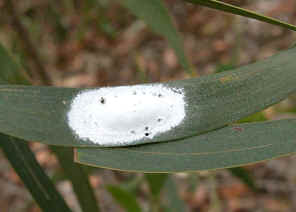
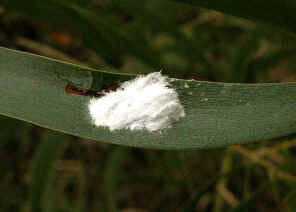
-
- There are about 30-80 eggs in one egg-plate.
-
- From the reference information, it suggested the Eurybrachyid Planthopper
is double brooded, i.e., there are two life cycle per year. There are the
winter nymphal state and summer nymphal state. We need more observations to
confirm this.
Nymphs
- Nymphs are
usually brown to dark brown in colour. Their habit are about the same as the
adults.
-

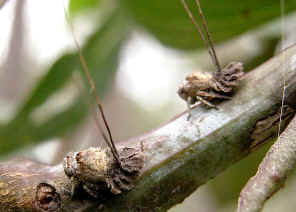

-
- Planthopper nymphs can be found on leaves, stems and tree trunks. They are
usually dark brown in colour, becomes lighter-brown colour when grown. Most
planthopper nymphs look very similar. The two long upwards pointing
"tails" are the characteristic.
-
-
Natural Enemy - Parasite Wasp
  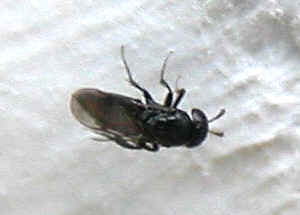 -
- The black dot was a small parasite wasp, about 2mm in body length. This
indicated that the eggs are infected of the wasp parasite.
-
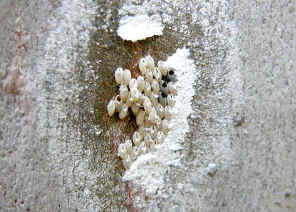 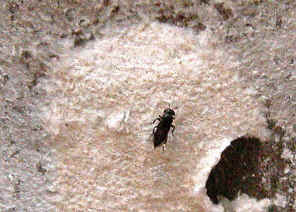 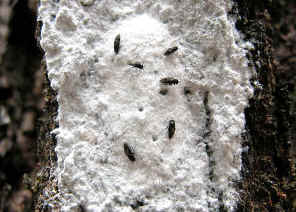 -
- From the above first picture, we can tell that there were four parasite wasps
hatched from the Planthopper egg-plate. There were four egg- shells with
circle opening, which are the typical bite mark of parasite wasps. The wasps
cut their way out using their mouth and made the round opening exit. The
egg-shells with the narrow broken mark were those not infected.
-
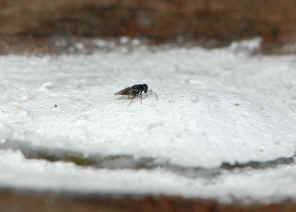
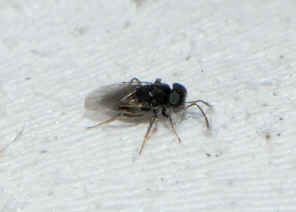
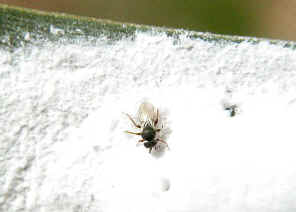 -
- We sometimes found those hopper egg-plate on wattle leaves. They are also
suffering the wasp parasite.
-
 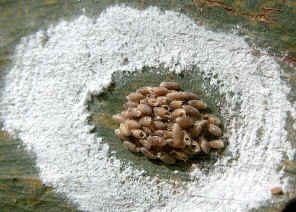 -
- If a round cut hole indicated the egg has been infected by parasite wasp,
most of the hopper eggs in the above picture were infected.
-
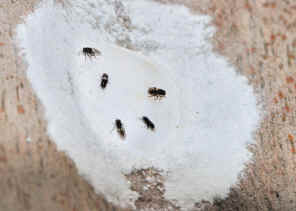 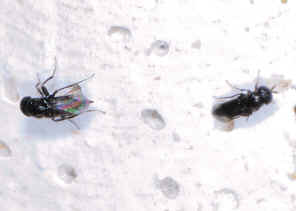 -
-
Natural Enemy - other insects

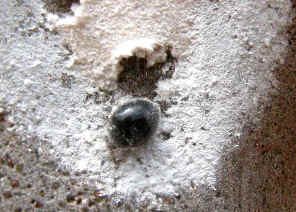 -
- In above pictures, at the lower side of the egg-plate, there is a beetle
feeding on the eggs.
-
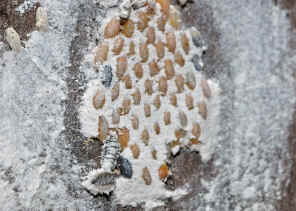
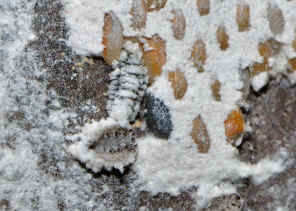 -
- Meanly-bugs are interesting on planthopper eggs as well.
-
-
-
Planthopper Adult Emerging

 -
- On Aug 2007 in Karawatha Forest, we found this planthopper nymph. Its body
size was large and fat. We thought it might be about time to turn into a
adult. So we collected it and kept it in a jar.
-



- 10:00pm
10:30pm
11:00pm
-
- In the same day at around 10:00pm, we found the planthopper was emerging.
The whole emerging insect was pale blue in colour, with pink legs. Then it
extended its wings to normal size and turned into dark brown colour.
-

  - 12:00pm
12:30pm
8:00am
-
- We might not have provided the best environment for the insect to emerge.
Its wings were a bit deformed.
-
Fake Head on Wings gives the Insect Second
Chance

 -
- Some species of planthopper have the eye-pattern on the wing tips.
-
- This Green Face Gum Hopper
also has the wing-tip eye patterns. In the second photo above the
planthopper's wings tip was broken, looks like had been
attacked by large predators. The eye patterns may have save its life, give
the planthopper second chance to live. The planthopper has the eye-pattern markings on their tail -end wing-tips.
Those markings effectively making the insects appear to be something that is
facing the opposite direction. A confused predator, when striking at the
mimic, most likely comes up with nothing more than a piece of wing and the
insects get a chance to escape. The mimicry is known as Self
mimicry.
-
Not so lucky this time
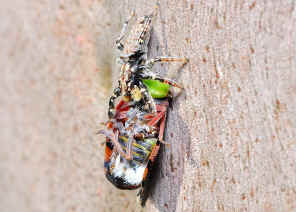
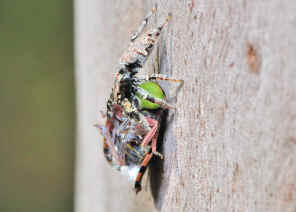 -
- A Green-faced Gum Hopper is on the Jumping
Spider's menu list.
- Reference:
- 1. Insects
of Australia, CSIRO, Division of Entomology, Melbourne University
Press, 2nd Edition 1991, pp 479.
- 2. Family Eurybrachyidae
- Fletcher, M.J. and Larivière, M.-C. (2001 and updates).
- 3. Genus
Platybrachys Stål sensu lato - By Murray J. Fletcher, 08 April 2007.
- 4. Species
of Eurybrachidae known to occur in Australia - By Murray J. Fletcher,
2009.
- 5. Checklist for Platybrachyini Schmidt, 1908 - Australian Faunal Directory, Australian Biological Resources Study, 2008.
- 6. Australian Insects - McKeown, K.C., Royal Zoological Society of New South Wales, Sydney.
1945, p130.
- Back to Top
[ Up ] [ Eurybrachyid Planthopper Biology ] [ Platybrachini ] [ Dardini ] [ Unknown Eurybrachyid ]
| |
|







































